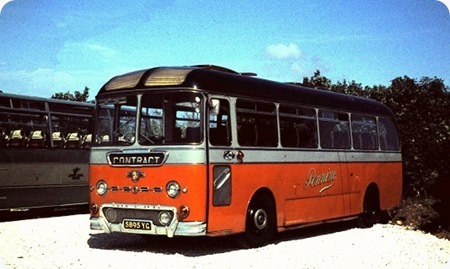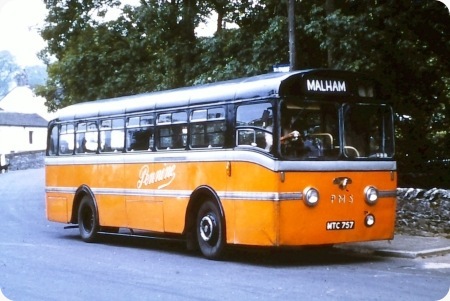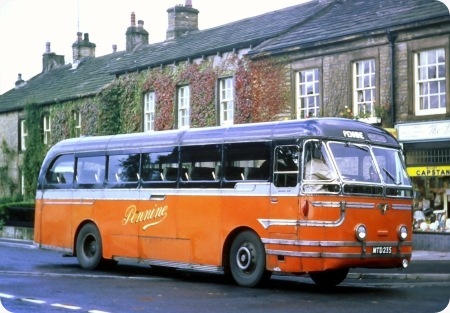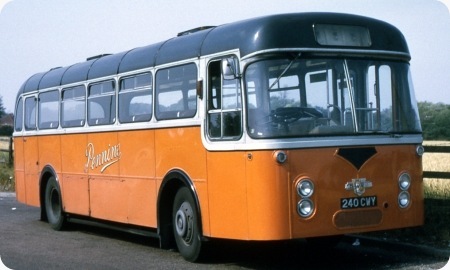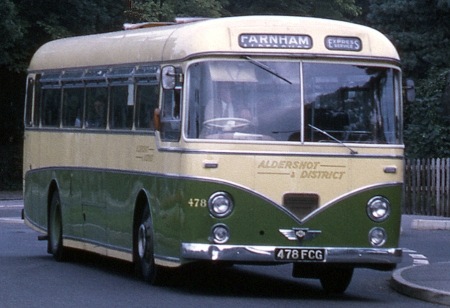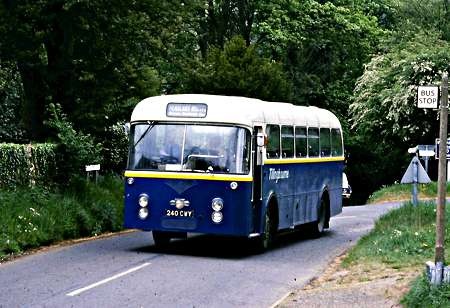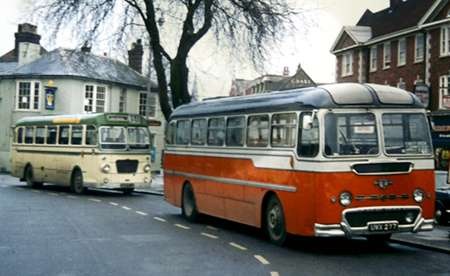Pennine Motor Services – Leyland Leopard – 5895 YG
Pennine Motor Services
1962
Leyland Leopard
Duple DP41F
Here is a photo of 5895 YG, Leyland Leopard with Duple body, in the fleet of Pennine Motor Services, then in Gargrave. I took the photo in Morecambe in June 1970. Note the SALOPIA vehicle alongside.
This vehicle was the last of four of this style, the other three being on Tiger Cubs UWX 277, 6108 WU and 9712 WX, so close inspection shows subtle changes over the years. The next new addition was 240 CWY, which Roger Cox posted elsewhere on the site a while ago.
Photograph and Copy contributed by Pete Davies
15/08/12 – 08:06
Herewith the conundrum as to what constitutes a C or a DP. Yelloway thought they were too bus like and only bought one batch but most things, including the entrance door, make this look more like a C than a DP. The same thing befell the Sheffield Transport Leopard/Burlinghams which were DP because they were based on a modified bus design rather than the Seagull – but they were really just as much coaches as their Weymann Fanfare and ECW contemporaries.
David Oldfield
15/08/12 – 11:34
Interesting point, David. From an operational point of view, the issue of whether a vehicle was a C or a DP generally depended on three factors: use, seating and livery. As OMO became more prevalent, provincial operators realised that front entrances enabled relatively easy and cheaper downgrading, especially if the eventual fate of new vehicles was considered when they were bought.
As for external appearance, a sensitive compromise was needed: too bus like, and passengers might feel they were being offered second best if they expected a coach; too coach like could mean problems displaying stage carriage destinations later in life.
Roy Burke
15/08/12 – 11:55
I’m not sure if it was still known as the ‘Donnington’ by this time but it definitely improved with age (like we do!) When it was first introduced, it had too many shallow side windows, perhaps a throwback to the old ‘Roadmaster’ design. This one, with just five deeper side windows is a great improvement and looks very nice. Yelloways were of the original design which would explain why they didn’t like them!
Chris Barker
15/08/12 – 14:47
The screen and front dome of the Donnington were shared with contemporary Willowbrook Viscount (cf Devon General). [Interesting how Duple recycled two Willowbrook names – Viceroy and Viscount.]
David Oldfield
15/08/12 – 14:48
The five bay version was known as the Donington 2 and was used by, among others, MacBraynes. I produced a resin kit of it in fact!
The design was built by the Duple Midland operation and was effectively superseded by the Britannia, which was very popular and shared the same front grille mouldings.
Andrew Goodwin
16/08/12 – 07:33
The correct spelling is Donington with one "n" – the body was named after the Donington Park motor-racing circuit close to the Duple Midland works in Loughborough. Donnington with "two ns" is in Shropshire.
As you say this version of the Donington (actually its third incarnation since the first prototype was built in 1956 – the first version was built from 1957-58 and lacked the "chain" motif in the front panel) is by far the most attractive due to the deeper windows.
I’m left a bit confused by the comment that "the Donington was replaced by the Britannia". The Britannia design was first introduced in 1956 and the last were produced in 1962, the same year in which the Donington was deleted from the Duple catalogue. Both models were replaced for the 1963 season by a choice of either the (Hendon built) Commodore or (Blackpool built) Commander. Dual purpose options then became the preserve of the Willowbrook subsidiary and were built to "BET standard" design.
Neville Mercer
16/08/12 – 14:24
Yes Neville, I assumed that the draughtsmen who wrote "Donington" on the drawings knew what they were doing!
I didn’t actually say it was replaced by the Britannia but my choice of words was perhaps unfortunate. What I meant to convey was the relative popularity of the Britannia as against the Donington leaving the latter with fewer sales.
As you will no doubt tell us there were at least three versions of the Britannia as well!
Reference the comment above about Willowbrook model names being recycled, Park Royal also did this with the name Royalist though the second version was anything but successful, not helped by being initially built on a second-string chassis rather than a front line player.
Andrew Goodwin
17/08/12 – 07:07
You’re quite right, Andrew, there were several versions of the Britannia. The original version, brought to market in 1956 to replace the Elizabethan, had a curved waist-rail and introduced the "chain motif" to the Duple range. All of this first version had front entrances, but were offered alongside the Britannic which had a central entrance and retained more of the styling of the Elizabethan. The Britannic was quietly dropped from the catalogue in 1957 and few were sold.
The second version of the Britannia formed part of a new range of designs exhibited at the 1958 CMS at Earls Court and shared many components with the new version of the Super Vega built on Bedford SB chassis. Basically similar bodies (but at that stage nameless) were also offered on Ford and Commer chassis. As far as I can tell from my own records the Mk II Britannia was only available with a front entrance at first, but from 1960 onwards a new central entrance design with a much more curved profile at the front end was also offered. The most famous of these were probably the examples operated by Samuelsons in London and St Helens Corporation.
There were minor detail changes to both front and central entrance versions in 1961, but you really have to look hard to see the difference – a tiny destination blind incorporated into the front bumper is the most visible clue.
By 1962 orders for both Britannias and for the Donington had reduced to a trickle due to competitive pressure from the much more stylish offerings from Plaxton and Harrington. Duple realised that it was losing its share of the heavyweight coach market, dumped the Britannia, Donington, Willowbrook Viking and Viscount, and the entire sadly bastardised Burlingham range from the catalogue, and replaced the lot with the Commander (with vertical window pillars) and the short-lived Commodore (with a "Bella" style raked back pillar towards the rear).
Sorry to go on, but as you might have noticed I have a thing about pre-1965 coach designs!
Neville Mercer
17/08/12 – 07:08
David and Roy have a valid point. Shortly after I joined Armstrong Galley ‘the coaching division of T&W PTE’ we took delivery of 15 Leyland Leopards GBB 985/999N fleet numbers 85/99 – 86/95 were 53 seaters with DP doors, but still had the comfort and overall look of a coach, and 96/99 were 45 seaters with coach doors, However, 85 was a totally different animal, it was in actual fact the first Alexander ‘T’ type ‘rumour has it that one or two of the Scottish bus group companies weren’t too pleased about it going to T&W’ but back to the plot, the vehicle itself was first class, but with the best will in the world it was a bus with coach seats. A/G did quite a lot of hire work for National Travel,and a fair amount of contract work, so 85 was always first choice for that, it was later transferred to the stage carriage fleet, and I think it was sold on after that
Ronnie Hoye
Sorry, should have said that the 14 coaches were Duple bodied
17/08/12 – 07:11
Externally all forms of the Donington look like buses to me, except when dolled up with Britannia/Vega trim, as here //sct61.org.uk/ It’s amazing what a few bits of metal and an association of ideas can do!
Peter Williamson
21/08/12 – 07:41
Castle Donington (one n in the middle!). The village has long suffered having people mis-spell its name, just as many folk think it is in Derbyshire because of the postal address, but it is in Leicestershire.
The Duple Donington body. Duple purchased the business of Nudd Brothers and Lockyer in 1952, renaming it Duple (Midland) Motor Bodies. Nudd’s premises were a hanger on the former Castle Donington airfield, now East Midlands Airport. Nudd had experience of metal framed bodywork, hence the Duple interest and the name of the design of the Duple metal framed body. The technology of the time may have resulted in the rather angular design and the small windows used at first.
Mr Anon
01/08/14 – 16:29
I found the comment on ‘DP’ v ‘C’ interesting, as I’ve never been quite sure where the difference lay, and there are clearly several ‘grey areas’. One of my main questions is how the Ribble PDR1 ‘White Lady’ Atlanteans justify the designation ‘coach’, at least among enthusiasts. The roughly contemporary Leopards with BET-style bodies by Marshall and MCW are always referred to as ‘DP’, though in terms of comfort, style or usage there was little to distinguish them from the Altlanteans; if anything the Leopards were marginally more coach-like internally and ventured further afield. But both types were effectively buses fitted with headrest seats and luggage racks, and consequently had the claustrophobic feel of being packed with a lot of stuff that they were not really designed for. Both were mainly used on relatively short inter-urban express services, at least one of which (the X43 Manchester-Skipton) was actually a stage carriage route at its country end. Doses it really just boil down to the double-deckers’ almost all-ivory livery, compared with rather more red on the saloons? But then in NBC days the Atlanteans (by then well past their unimpressive best) were given service bus livery, while the Leopards got the DP treatment! Was it just that the Atlanteans hijacked the justified ‘C’ designation of their upmarket cousins, the ‘Gay Hostesses’? And as for the earlier generation of Titan ‘White Ladies’ — though admittedly I’m too young to remember very much about them — how could anything lowbridge ever really be called a coach, however much chrome you put on the outside?
Keith
15/10/19 – 05:48
This coach finished it’s day parked along the workshop at Berresford Motors Limited in the role of mess room. I believe it was still in situ when the business was sold to PMT.
Leekensian
Quick links to the - Comments Page - Contact Page - Home Page
